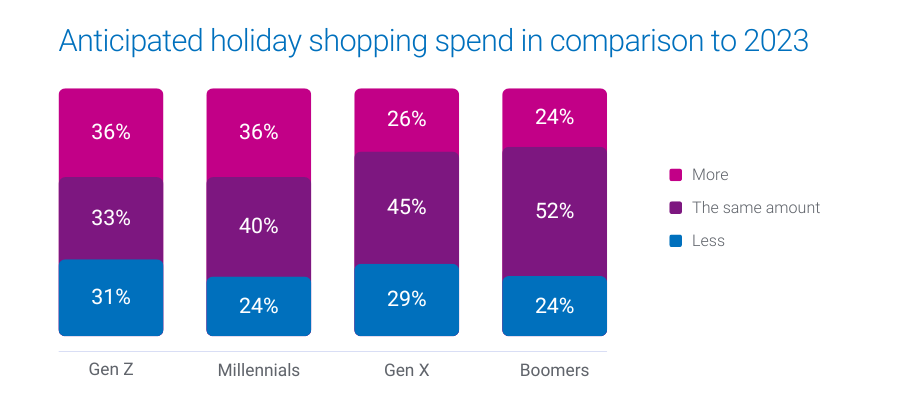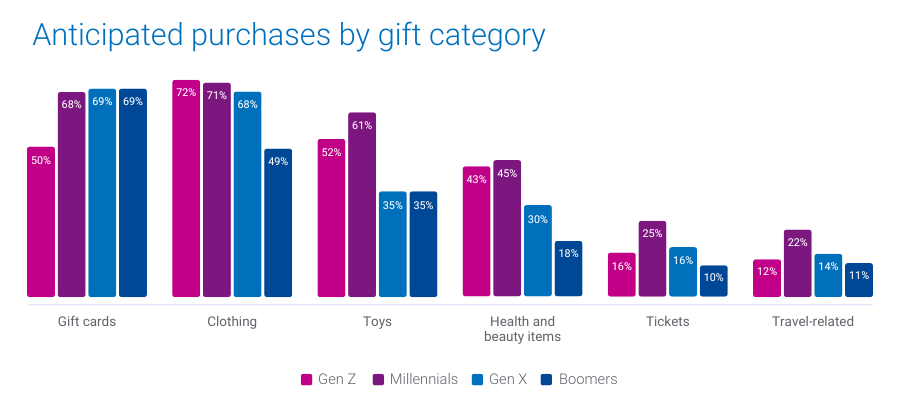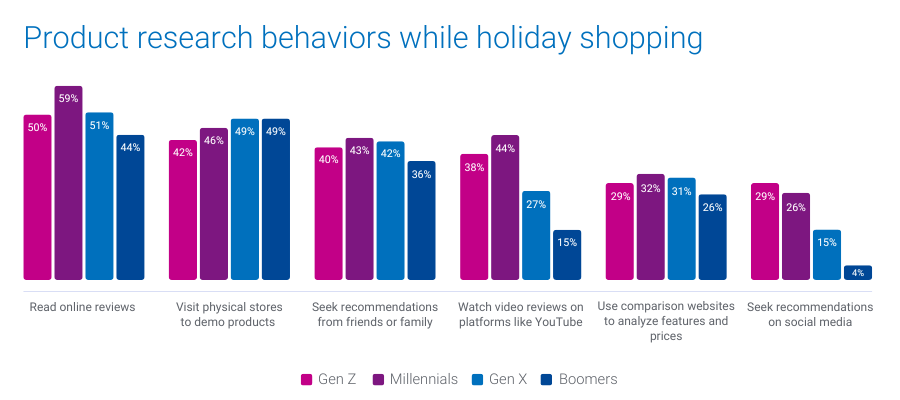
The holiday season is almost here, and knowing how each generation plans to shop can give your holiday advertising campaigns the edge you need. Our recent survey of 1,000 U.S. consumers reveals 2024 holiday shopping trends for each generation and key insights into their anticipated spending levels, preferred shopping categories, and how they look for gift ideas.
In this blog post, we’ll explore three 2024 holiday shopping trends across generations:
- Projected consumer spending
- Top categories on shoppers’ lists
- Preferred channels for researching gifts
1. Projected consumer spending
Over 1 in 3 Gen Z and Millennials are gearing up to increase their holiday budgets this year, while Gen X and Boomers are likelier to stick to last year’s budget.
- 36% of Millennials and Gen Z plan to spend more this holiday season
- 45% of Gen X and 52% of Boomers expect their spending to remain consistent with last year

What this means for marketers
These insights highlight the importance of tailoring your messaging. For Gen Z and Millennials, emphasize value and unique offerings that justify increased spending. For Gen X and Boomers, focus on trust and reliability, reinforcing their confidence in your brand.
How Experian can help you target these audiences
Experian’s custom and syndicated audience segments, including Holiday Shopper High Spenders and Holiday Shopper Moderate Spenders, enable you to connect with these diverse consumer groups. Our audiences are available on-the-shelf of leading ad platforms to help you reach people across social, TV, and mobile.
The election effect
U.S. holiday retail sales saw 4.1% YoY growth in 2016 and 8.3% YoY growth in 2020 following presidential elections. There’s a chance that holiday spending increases after the 2024 election, regardless of the outcome. Experian has 240+ politically relevant audiences that you can activate across major ad platforms ahead of the upcoming election.
2. Top categories on shoppers’ lists
Different generations have distinct preferences when it comes to what they plan to buy. Gift cards top the list for Gen X and Boomers, while Gen Z leans toward clothing. Millennials are looking to splurge on toys, electronics, and experiences.
- 69% of Boomers and Gen X plan to purchase gift cards
- 72% of Gen Z will buy clothing
- 45% of Millennials will buy health and beauty items
- 25% of Millennials will buy tickets and 22% of Millennials will buy experiences

What this means for marketers
Align your product offerings and promotions with each generation’s preferences to capture their attention. For example, highlighting versatile gift cards may resonate more with older generations, while showcasing trendy apparel and tech gadgets will appeal to younger consumers.
How Experian can help you target these shoppers
We offer audience segments like Holiday Shoppers: Apparel, Cosmetics & Beauty Spenders, and Toys Shoppers that you can activate to connect with consumers primed to purchase in these categories.
We recently released 19 new holiday shopping audiences we recommend targeting to drive engagement and conversions. Download our audience recommendations here.
3. Preferred channels for researching gift ideas
When it comes to finding the perfect gifts, Gen Z turns to social media, while Millennials prefer online reviews and video content. Boomers and Gen X are more inclined to visit physical stores for hands-on product evaluations.
- 29% of Gen Z and 26% of Millennials will look for gift ideas on social media
- 44% of Millennials will rely on video reviews and product demos on platforms like YouTube
- 49% of Gen X and Boomers plan to visit physical stores to evaluate products in person

What this means for marketers
Understanding where each generation looks for inspiration can guide your content and ad placement strategy. To engage Gen Z, focus on social media campaigns and influencer partnerships. For Millennials, consider investing in video content and reviews. For older generations, ensure your in-store experience is optimized to convert browsing into purchases.
How Experian can help you engage these shoppers
Our TrueTouchTM audiences can help you pair the perfect messaging styles with the right channels and calls to action. Our Social media channel and content engagement audiences can help you reach Gen Z who are likely to be active users on major social platforms and are Black Friday shoppers. For a full list of Experian’s syndicated audiences and activation destinations, download our syndicated audiences guide.
Download our report for five 2024 holiday shopping trends by generation
Understanding 2024 holiday shopping trends by generation can help you tailor your targeting, messaging, media planning, and creative based on the generation you’re targeting.
In addition to the insights covered here, download our 2024 Holiday spending trends and insights report to learn:
- When consumers plan to shop (hint: they’re already shopping)
- Where they plan to shop (online vs. in-store)
Download our full report to access all five of our predictions by generation, so you can address the diverse needs of this year’s holiday shoppers.
When you work with Experian for your holiday shopping campaigns, you’re getting:
- Accurate consumer insights: Better understand your customers’ behavioral and demographic attributes with our #1 ranked data covering the full U.S. population.
- Signal-agnostic identity solutions: Our deep understanding of people in the offline and digital worlds provides you with a persistent linkage of personally identifiable information (PII) data and digital IDs, ensuring you accurate cross-device targeting, addressability and measurement.
- Secure connectivity: Bring data and identity to life in a way that meets your needs by securely sharing data between partners, utilizing the integrations we have across the ecosystem, and using our marketing data in flexible ways.
Make the most of this holiday shopping season with Experian. Contact us today to get started.
Source
Online survey conducted in June, 2024 among n=1,000 U.S. adults 18+. Sample balanced to look like the general population on key demographics (age, gender, household income, ethnicity, and region).
Latest posts

The holiday season is right around the corner and retailers are gearing up for a massive influx of customers, both new visitors and returning loyal patrons. But, organizations need to make sure they’re prepared to handle the influx of business. Data quality should be a priority for retailers at any time of year, but even more so as the holiday season approaches. During this time, it’s important for companies to provide customers with relevant shopping offers. When consumers shop for holiday gifts for their friends and families, they have countless directions to which they can turn. In order to prevail in competition, retailers need to provide customers with relevant offers and messages. Unfortunately, many businesses fall short in this regard. According to recent research from Experian QAS, organizations feel that, on average, 25 percent of their data is inaccurate. Consumers are frantically looking to find deals on products that meet their holiday needs, but loyalty offers may not be reaching consumers. One reason for the difficulty is the messy nature of companies’ customer databases. Retail businesses are working hard to gather as much information as possible about the consumers who patronize them, but all too often, information is riddled with errors. These errors have become more prevalent in recent years due to the proliferation of mobile apps, web interfaces and social media channels. There are so many different channels that companies now interact with people through an average of 3.27 channels. This poor data quality is hurting organizational bottom lines. Experian QAS found that an average of 12 percent of departmental budgets are wasted due to inaccuracies in contact data. During the 2013 holiday season, consumer spending is expected to increase by at least 11 percent. Retailers need to be certain that they improve data quality prior to the holiday season to ensure communications reach consumers and resources are maximized in order to take advantage of the expected increase. Be sure to check out our new data quality infographic.

Experian Marketing Services’ Head of Global Research Bill Tancer appeared recently on Fox Business News to talk about new holiday shopping trends, including why both retailers and consumers are starting the 2013 season earlier this year. “We are seeing the eventual extinction of Black Friday,” says Tancer. “What we see in our data is that retail is really changing. The consumer is relentlessly searching for that deal.” In fact, as Tancer notes, the hyper-connected, digital consumer is already searching for holiday deals. Hear more from Tancer in this clip. Watch the latest video at video.foxbusiness.com Tancer and other Experian Marketing Services data experts will discuss holiday marketing trends at an upcoming webinar; register for more insights and tips.

On some level, collecting data and analyzing it to find meaningful conclusions has always been part of how marketers go about connecting with consumers. Their strategies have improved dramatically over time, though. Perhaps in a previous era, marketing executives were only able to make sweeping generalizations about large swathes of the population. But, as marketers have gathered more data on individual consumers, they’ve found ways to fine-tune their searches. They’re no longer messaging to groups in vague terms. Smart Data Collective recently examined the marketing world’s transition away from broad stereotyping toward better targeted forms of data mining. Josh Brown, a member of the marketing team at business and IT consulting company Iconic Mind, argues that this era of overgeneralization is coming to an end. We now have the capability to zoom in on the specific customer. “Big data is how successful companies are building more detailed models of consumer behavior,” Brown wrote. “Instead of relying on the traditional demographic models that marketers used when we were operating in a mass consumption environment and had nothing better, big data capitalizes on developing market trends to allow businesses to become far more specific when segmenting their customers.” Brown cited Amazon.com as an example. The online superstore is notable for its targeted recommendations of products that shoppers see every time they log on to the site – the advisements are impressive because they’re usually right up the customer’s alley. Amazon doesn’t generate these ideas by making guesses based on whether the consumer is old or young, male or female – instead, the site takes in specific information about people’s buying histories and looks for similar products. This approach is quickly becoming mainstream. It’s not hard to understand why – people don’t like being reduced to profiles of their demographic characteristics. Consumers are expecting more from the companies they do business with. Thanks to the rapidly improving technologies that companies use for data collection, marketers can be more targeted and make more intelligent interactions. However, to take advantage of these new technologies, marketers need to maintain high quality data. Without a data quality strategy, customer information will be spread out across the organization, making it difficult to make intelligent marketing offers. To learn more about improving your understanding of consumers, check-out our infographic on building a single customer view.